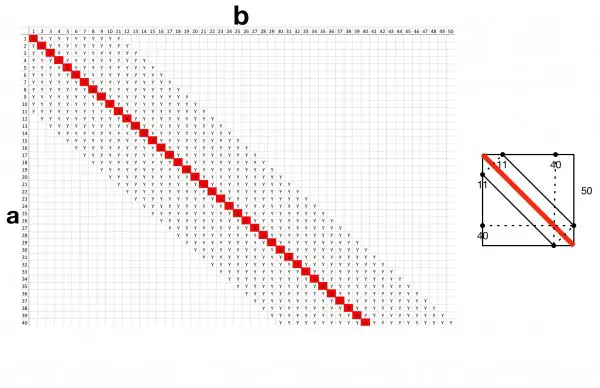After one number, a, is drawn, 49 remain. Let's suppose a=1, then the numbers 2-11 (10 tickets) would satisfy the criterion that b, the second number, satisfies |b-a|≤10. So that's 10/49. If a=2, then if b=1 or 3≤b≤12 |b-a|≤10. That's 11 tickets, 11/49. If a=25, 15≤b≤24 or 26≤b≤35, that's 20 tickets, 20/49. If a=30, then 20≤b≤29 or 31≤b≤40, 20 tickets again, 20/49. The rule is then that for 11≤a≤40 the probability for b is 20/49. The probability of picking a in range for this probability for b is 30/50. The combined probability is 30/50*20/49=12/49.
At the other end of the scale for 50≥a≥41 we have the same probabilities as for 1≤a≤10; when a=50, b can be 40-49 (10 tickets); when a=49, b can be 50 or 39-48 (11 tickets), and so on.
We can put together a 50X50 table, but we can also summarise it:

("Y" means "yes, the values of 'a' (row number) and 'b' (column number) represented by this little square satisfy |a-b|≤10".)
The small square with the red diagonal represents the whole of the large table on the left, which is only shown up to its 40th row. The red diagonal, containing X's for no-go, or disallowed combinations, excludes a=b. One way of calculating probability is to work out the fraction (number of "successful " events) ÷ (total possible number of events). This is the same as dividing the "area" occupied by Y's in the table by the "area" of the table itself, excluding the red diagonal. This is better represented by the small square with the red diagonal.
This approach of using areas is the fastest way to arrive at the probability and it's easy to calculate:
Area of table=50^2-50=2450=50*49 (there are 50 red squares in the red diagonal to be removed).
Area of a trapezoidal corner piece=19+18+...+10=145. Total area of both trapezoids=290.
(The right-angled trapezoids are formed by the Y's in rows a=1 to 10 and b=1 to 20, and a=41 to 50 and b=31 to 50. The trapezoid consists of a 10X10 square=100, less the diagonal of 10, which makes 90; and a right-angled triangle containing 55 Y's. Total 145. Not the usual way of calculating the area of a triangle!)
Area of central "parallelogram"=30*20=600.
Total area of Y's (central band)=890. So the probability of picking two numbered tickets, the difference of which is 10 or less, is 890/2450=89/245.
In case you're not convinced that this simple solution is correct, let's go back to the calculations at the beginning.
For any particular value of a there's always a 1/50 probability of picking it, but, depending on the value we have varying probabilities for b. Take a=1: the combined probability of |a-b|≤10 is 1/50*10/49; for a=2 it's 1/50*11/49, giving us the progression: 1/50*10/49+1/50*11/49+1/50*12/49+...+1/50*19/49. This also applies to a=50, a=49, ..., a=41. The total probability for the "ends" is (2/2450)(10+11+12+...+19)=2*145/2450.
In the "middle section" we have constant 20/49 for b in the range 11≤a≤40=30/50*20/49=600=600/2450.
The total is (290+600)/2450=890/2450=89/245. So the figures match the "areas".